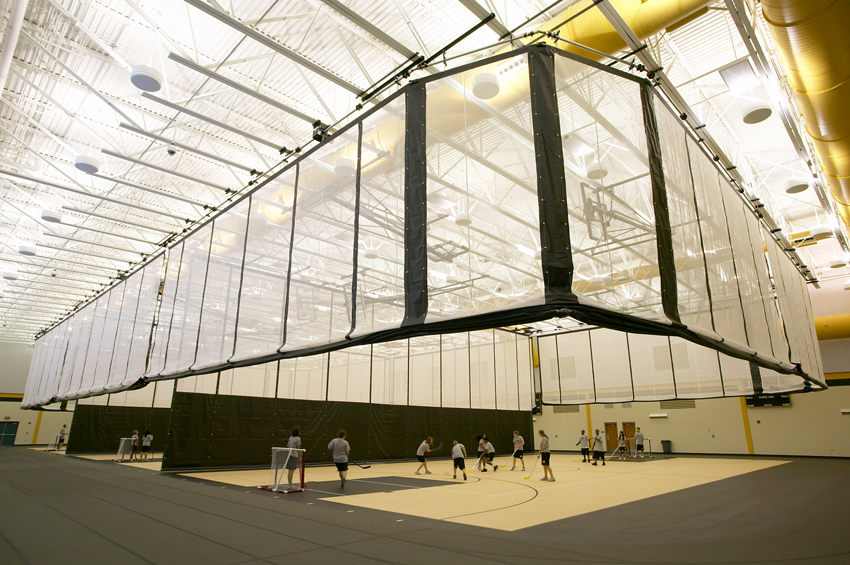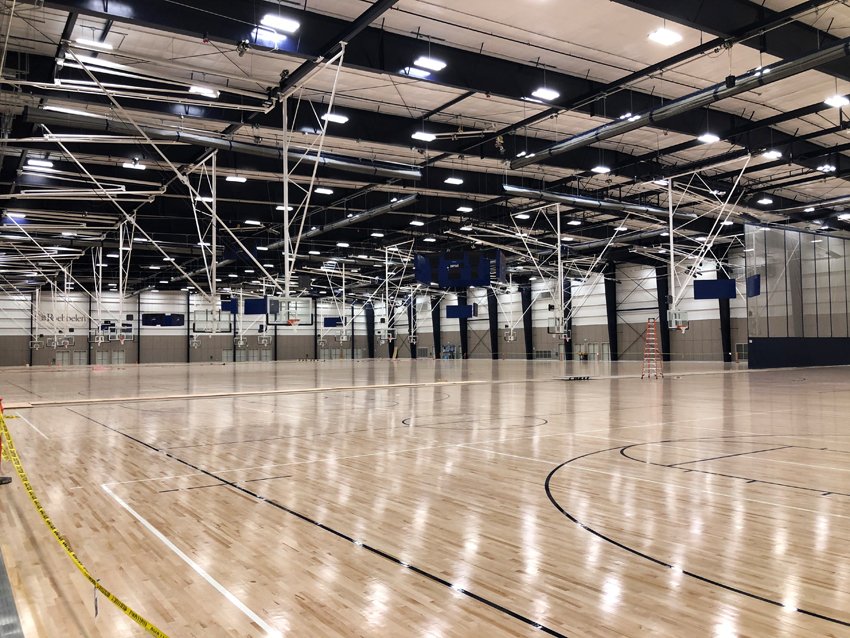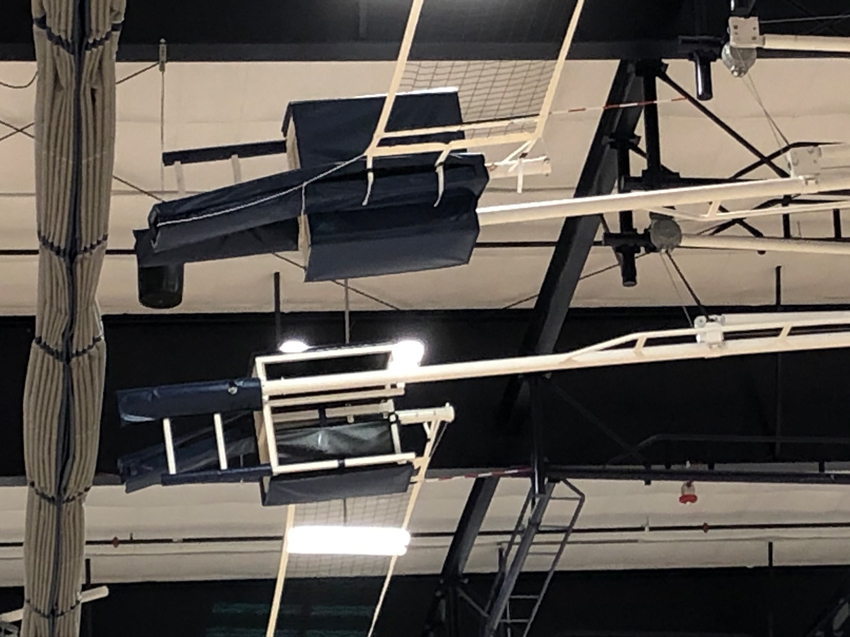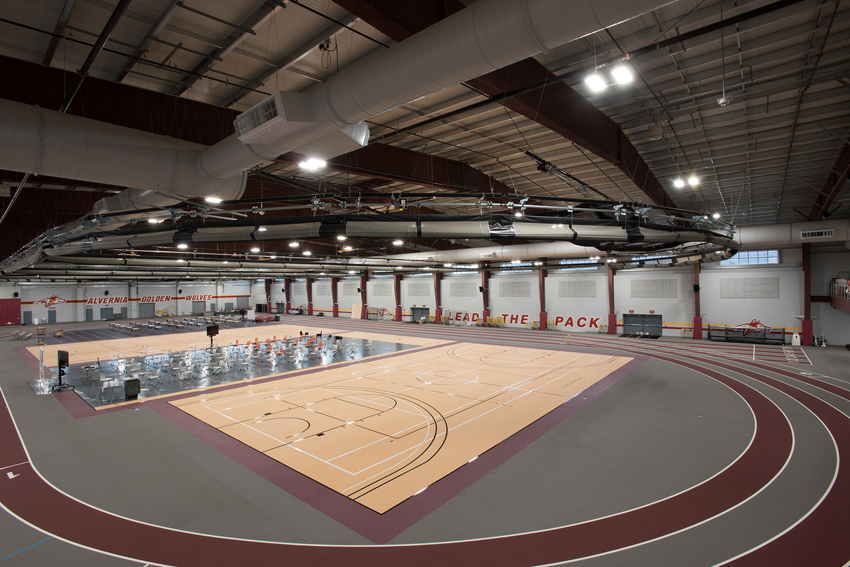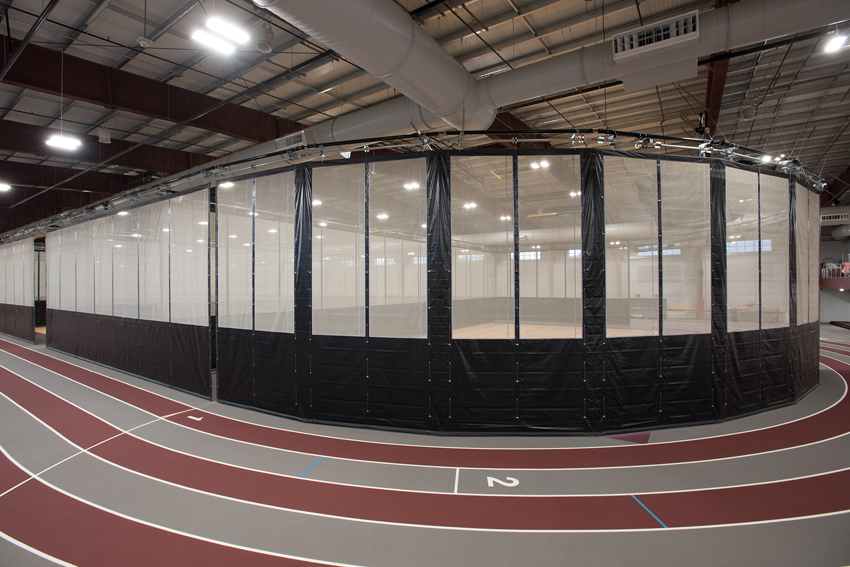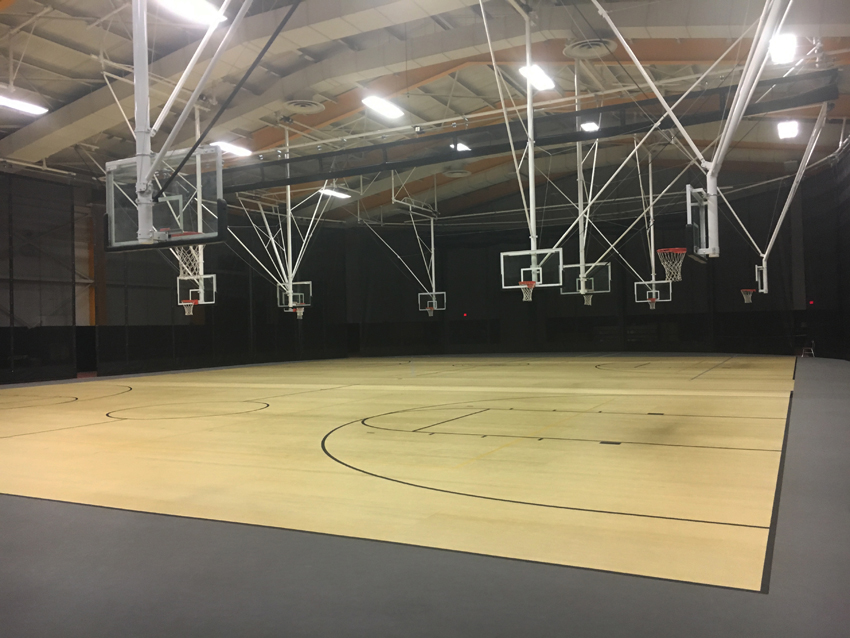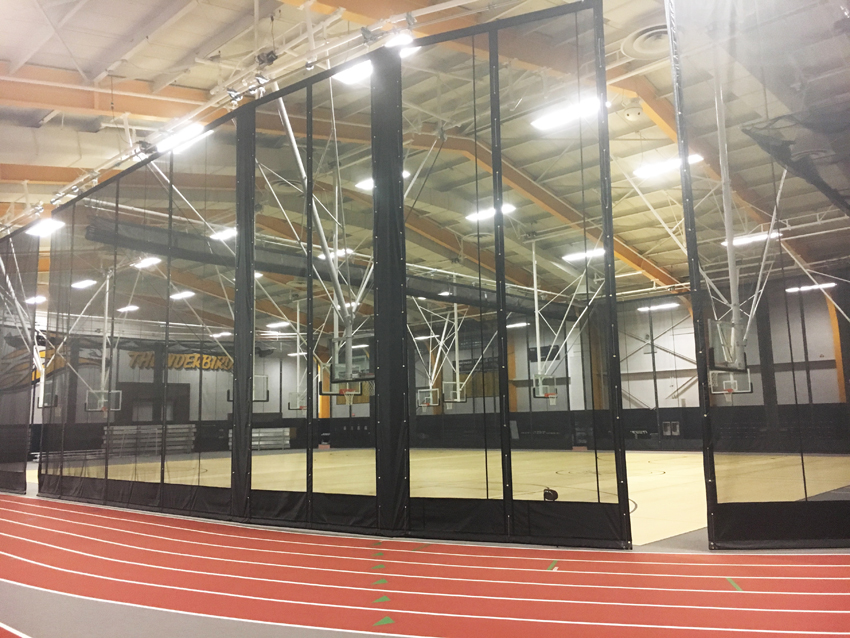This CE Center article is no longer eligible for receiving credits.
From high school gymnasiums to community recreational centers to collegiate athletic facilities, indoor sports are a major source of activity, physical education, exercise, and socialization within our schools and communities.
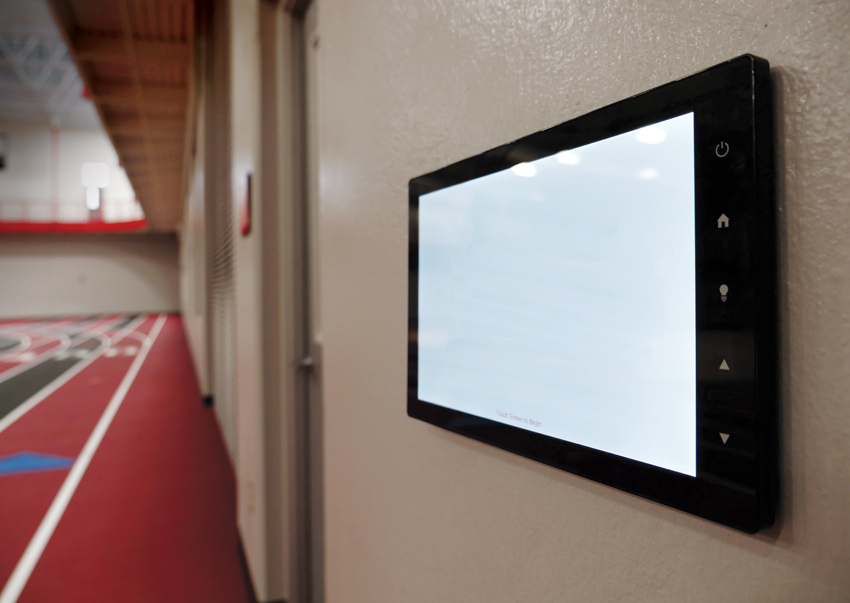
Photo courtesy of Draper Inc.
A custom programmed control system allows gymnasium setups to be changed quickly and provide a way for facilities to safely host more than one activity at a time, as shown here at Center Grove High School located in Greenwood, Indiana.
While high-quality basketball and volleyball equipment are essential for supporting safe and enjoyable classes, practices, and games, it is also important that facility managers can safely and efficiently control and reconfigure the gymnasium equipment on a regular basis.
The key to achieving the latter is through the thoughtful application of control systems. These can range from simple key switches to canned group control systems all the way up to high-end custom programmed control systems. Whatever the case may be, the most efficient, cost-effective control solutions can only be achieved with preplanning between the facility owner, architect, contractor, and controls equipment manufacturer.
While stationary backstops and/or wall-mounted backstops folded with manually operated winches are an option for gym owners, ceiling-suspended units folded with motorized winches are by far the most commonly specified for today’s gymnasiums. (See the Ceiling-Suspended Systems sidebar for additional information on this topic.)
Before delving into the details of the different gymnasium equipment control systems and project planning process, architects should be aware of a few general safety principles when it comes to heavy overhead gymnasium equipment.
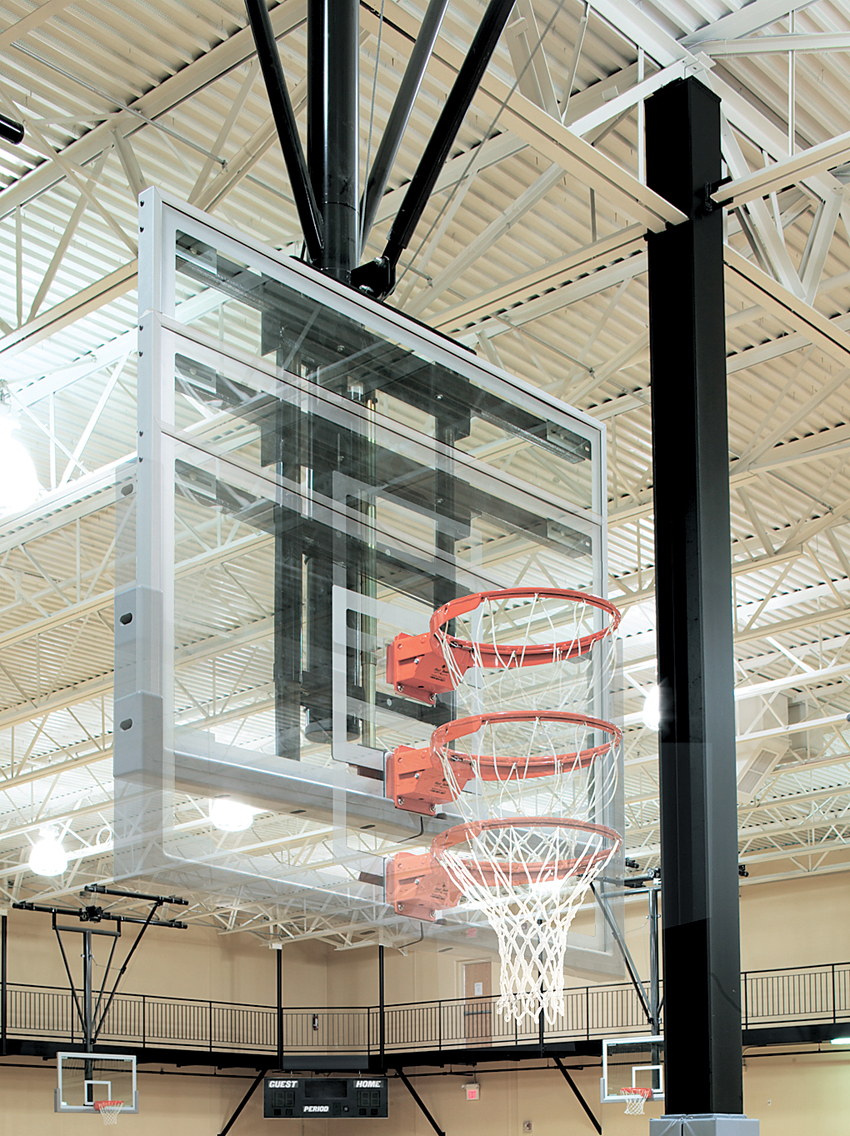
Photo: Jeff Bell Photography
Electric height adjusters are among the equipment that is controlled by a control system, as shown here at the ArchBold Evangelical Church in Archbold, Ohio.
Gymnasium Equipment Control Safety
Because gym equipment like basketball backboards suspended overhead weigh thousands of pounds, it is essential that the equipment be raised and lowered in a safe manner. Consequently, only authorized and properly trained individuals should operate the equipment. Further, the equipment should never be operated when people are underneath or in the area around it.
When controlling the equipment, the individual raising or lowering the backboard, volleyball net, or gym divider curtains, for example, must be in full view of the equipment the entire time that it is in motion. All control systems also require a key or password to prevent unauthorized users from operating the equipment.
In an Athletic Business article titled “Technology Makes Accommodating Gym Activities Easy,” Senior Editor Paul Steinbach writes, “Most systems in place today, including those still employing individual key switches, require continuous contact with the controller while the equipment is in motion. If at any point a button or key is released, the equipment stops instantly—a handy feature when a potential obstacle has been spotted.”
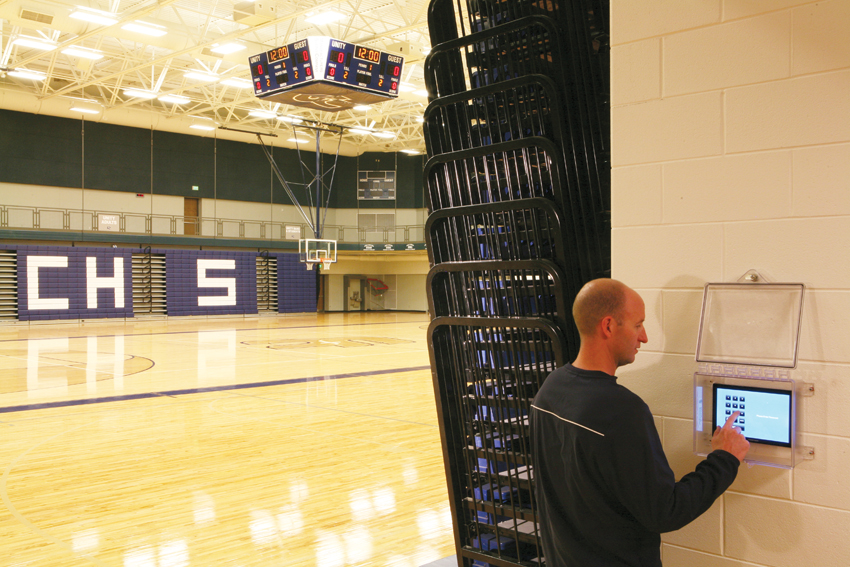
Photo courtesy of Draper Inc.
When operating heavy gymnasium equipment, the facility manager must be in full view of the equipment, and continuous contact with the controller is required while the equipment is in motion.
Key Switches
The most basic control for gym equipment is key switches where one piece of equipment is operated from each key switch with a dedicated circuit for each device. Switches are available from one key on a single-gang plate up to seven keys on a seven-gang cover plate. The technology is very reliable and secure, assuming keys are only issued to trained and authorized individuals.
To maximize effectiveness and safety, it is important to avoid some field-observed pitfalls. These include leaving keys in switches, which effectively leaves the control open for anyone to operate. Without proper training, unauthorized users can potentially operate equipment in a dangerous manner.
Another problematic issue is simultaneously running multiple devices by holding down multiple key switches at the same time in a manner that leaves the user unable to observe equipment in operation. Users should also be cautioned against using broom handles, heavy chains of keys, or other methods to hold the switch in an on position while the operator walks away and fails to supervise the raising and lowering of very heavy equipment.
Wireless Remote Controls
The first advancement beyond key switches was the introduction of wireless remote controls more than 30 years ago. Wireless controls work with a receiver at each motor and handheld transmitter, similar to a garage door opening system. The receivers are programmed, frequently with dip switches, and each device is assigned its own unique channel. Operated by radio frequency (RF), the users select the chosen channel from the transmitter, but they must be physically located no more than 100–125 feet in proximity to the receiver.
Though it is very rare, there is a small possibility that the transmitter could interfere with other RF devices or encounter interference.
Higher-quality wireless systems will prohibit multiple transmitters from attempting to operate at the same time by locking out the other channels while one device is being operated. Consequently, a second and third transmitter, for example, will not be able to access any channel for multiple wireless operations. This means that users are typically restricted to operate one device at a time. Groups can be created by setting more than one receiver at the same frequency, but then the ability to individually operate devices at that frequency is lost.
To prevent unauthorized users from activating the controls, the handheld transmitter should be kept under lock and key and not mounted to the wall where anyone can access it. There is an option to add a low-voltage key switch as a backup in case the remote control is lost or dropped.
A major benefit with wireless controls is that that they eliminate the need to pull wire to key switches down on the wall, as the system only needs power at the winch in the ceiling. Consequently, wireless works well for retrofits or renovations.
From high school gymnasiums to community recreational centers to collegiate athletic facilities, indoor sports are a major source of activity, physical education, exercise, and socialization within our schools and communities.

Photo courtesy of Draper Inc.
A custom programmed control system allows gymnasium setups to be changed quickly and provide a way for facilities to safely host more than one activity at a time, as shown here at Center Grove High School located in Greenwood, Indiana.
While high-quality basketball and volleyball equipment are essential for supporting safe and enjoyable classes, practices, and games, it is also important that facility managers can safely and efficiently control and reconfigure the gymnasium equipment on a regular basis.
The key to achieving the latter is through the thoughtful application of control systems. These can range from simple key switches to canned group control systems all the way up to high-end custom programmed control systems. Whatever the case may be, the most efficient, cost-effective control solutions can only be achieved with preplanning between the facility owner, architect, contractor, and controls equipment manufacturer.
While stationary backstops and/or wall-mounted backstops folded with manually operated winches are an option for gym owners, ceiling-suspended units folded with motorized winches are by far the most commonly specified for today’s gymnasiums. (See the Ceiling-Suspended Systems sidebar for additional information on this topic.)
Before delving into the details of the different gymnasium equipment control systems and project planning process, architects should be aware of a few general safety principles when it comes to heavy overhead gymnasium equipment.

Photo: Jeff Bell Photography
Electric height adjusters are among the equipment that is controlled by a control system, as shown here at the ArchBold Evangelical Church in Archbold, Ohio.
Gymnasium Equipment Control Safety
Because gym equipment like basketball backboards suspended overhead weigh thousands of pounds, it is essential that the equipment be raised and lowered in a safe manner. Consequently, only authorized and properly trained individuals should operate the equipment. Further, the equipment should never be operated when people are underneath or in the area around it.
When controlling the equipment, the individual raising or lowering the backboard, volleyball net, or gym divider curtains, for example, must be in full view of the equipment the entire time that it is in motion. All control systems also require a key or password to prevent unauthorized users from operating the equipment.
In an Athletic Business article titled “Technology Makes Accommodating Gym Activities Easy,” Senior Editor Paul Steinbach writes, “Most systems in place today, including those still employing individual key switches, require continuous contact with the controller while the equipment is in motion. If at any point a button or key is released, the equipment stops instantly—a handy feature when a potential obstacle has been spotted.”

Photo courtesy of Draper Inc.
When operating heavy gymnasium equipment, the facility manager must be in full view of the equipment, and continuous contact with the controller is required while the equipment is in motion.
Key Switches
The most basic control for gym equipment is key switches where one piece of equipment is operated from each key switch with a dedicated circuit for each device. Switches are available from one key on a single-gang plate up to seven keys on a seven-gang cover plate. The technology is very reliable and secure, assuming keys are only issued to trained and authorized individuals.
To maximize effectiveness and safety, it is important to avoid some field-observed pitfalls. These include leaving keys in switches, which effectively leaves the control open for anyone to operate. Without proper training, unauthorized users can potentially operate equipment in a dangerous manner.
Another problematic issue is simultaneously running multiple devices by holding down multiple key switches at the same time in a manner that leaves the user unable to observe equipment in operation. Users should also be cautioned against using broom handles, heavy chains of keys, or other methods to hold the switch in an on position while the operator walks away and fails to supervise the raising and lowering of very heavy equipment.
Wireless Remote Controls
The first advancement beyond key switches was the introduction of wireless remote controls more than 30 years ago. Wireless controls work with a receiver at each motor and handheld transmitter, similar to a garage door opening system. The receivers are programmed, frequently with dip switches, and each device is assigned its own unique channel. Operated by radio frequency (RF), the users select the chosen channel from the transmitter, but they must be physically located no more than 100–125 feet in proximity to the receiver.
Though it is very rare, there is a small possibility that the transmitter could interfere with other RF devices or encounter interference.
Higher-quality wireless systems will prohibit multiple transmitters from attempting to operate at the same time by locking out the other channels while one device is being operated. Consequently, a second and third transmitter, for example, will not be able to access any channel for multiple wireless operations. This means that users are typically restricted to operate one device at a time. Groups can be created by setting more than one receiver at the same frequency, but then the ability to individually operate devices at that frequency is lost.
To prevent unauthorized users from activating the controls, the handheld transmitter should be kept under lock and key and not mounted to the wall where anyone can access it. There is an option to add a low-voltage key switch as a backup in case the remote control is lost or dropped.
A major benefit with wireless controls is that that they eliminate the need to pull wire to key switches down on the wall, as the system only needs power at the winch in the ceiling. Consequently, wireless works well for retrofits or renovations.
Group Control Systems
Group control systems allow for more flexibility in controlling gym equipment. Many systems can share circuits and may even require it. The password-protected system is controlled by turning the relays on and off. Because multiple devices can operate simultaneously, this significantly decreases setup time between games or events.
Group control systems typically fall into one of two categories: canned field programmed systems with limited programming options, and custom programed systems that are more flexible and can be tailored to a facility’s specific requirements.
Canned systems are more economical, as the cost can be offset by savings on electrical costs if the system is large enough.
The systems are usually operated with a numerical keypad. Some have LED lights to communicate back to the user, and some incorporate LCD screens for communication. The system should include a visual guide or legend to help the user identify each component within the system.
Preconfigured relay boxes, typically with eight sets of two relays, can be networked to increase system capacity.
The system requires shared circuits because it functions as a distribution system for the electrical circuit. Multiple relays are fed with a single circuit, and the operator tells the system which devices/relays to operate by interfacing with the keypad.
Most relay boxes are connected to more than one circuit to allow the creation of groups. At the same time, the system should include a way to prevent overloaded circuits.
For most canned systems, each relay box is fed with two 30-amp circuits to enable two devices per circuit to operate simultaneously. This allows up to four devices per relay box, two on each circuit, to run together. The group sizes are typically capped at eight devices, which requires two or more relay boxes with two 30-amp circuits each. The data is conveyed via two low-voltage and communication cables from the keypad to the relay box. Keypads typically mount in commercially available recessed switch/electrical boxes.
The electrical code permits loading a circuit to a maximum of 80 percent, which means that each 30-amp circuit feeding the control system can carry up to a 24-amp load. This would be the equivalent of running two motors simultaneously (i.e., two backstops or two divider curtains). Because a typical gym is configured with six back stops, this means that operators can put the two main back courts on the same group, which subsequently cuts the setup time in half. However, the group of devices must all run up or down. It is not possible to concurrently send one up and bring another down.
Historically, a basic control system in the early 2000s would run one device at a time. Some 10 years ago, the basic system became a little more sophisticated, allowing users to create groups, so circuit sizes were changed from 20 amps to 30 amps.
Today, users can include two devices on one 30-amp circuit and an additional two on a second 30-amp circuit. If more than one relay box is utilized, another four devices (two per 30-amp circuit) can be added, and it now becomes possible to simultaneously operate eight devices at a time. However, the canned systems typically cap group sizes here.
With a typical price tag of under $5,000, for projects where budget is an issue but the owner wants the control system to have the capability of sharing circuits and operating equipment in groups, a canned system could be a good solution. However, there is limited programmability and less sophistication. For example, the user interface usually looks like a telephone touchpad with numerical controls.

Photo courtesy of Draper Inc.
Group control allows multiple pieces of equipment to be moved simultaneously, as shown here at Center Grove High School.
Custom Programmed Systems
With a larger front-end investment, custom programmed systems are a more feature-rich option. Consequently, the system can be programmed to match the facility’s exact requirements.
This is particularly beneficial for pay-to-play or other large multiuse facilities that frequently change their setup for the next group coming in. The ability to operate multiple pieces of equipment at one time significantly reduces down time between facility bookings and labor costs to operate equipment for switchovers. Whereas with key switches, the switch must be held down to move one piece of equipment at a time, these advanced systems can move the equipment in a fraction of the time.
For example, a row of courts with six basketball backstops and six overhead volleyball systems can all be activated at the push of a button. With this example, all 12 pieces of equipment running together would take about 3 minutes to fully fold, whereas with individual key switches, it could take up to 36 minutes to fold all 12.
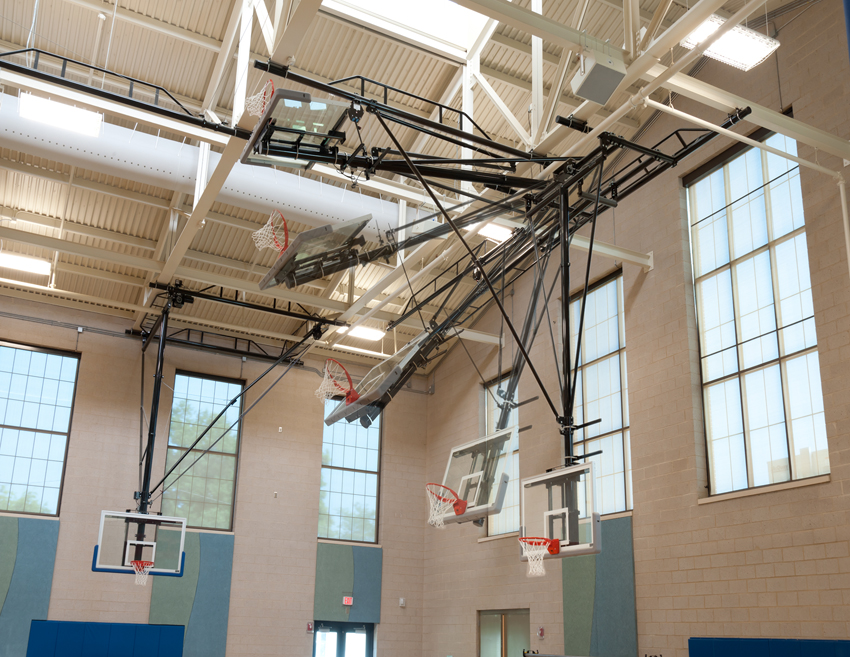
Photo courtesy of Draper Inc.
The ability to fold equipment up to the ceiling is key to supporting a multipurpose facility used for assorted sports and events.
With the ability to share circuits, building owners can often recoup their investment through electrical savings on larger jobs.
That said, there are some limitations on how many devices can be grouped together, circuit sizes, number of circuits, and what an operator can reasonably observe operating simultaneously, as he or she must still be able to watch the equipment during operation.
Custom programmed systems are typically comprised of relay boxes, an interface, and a processor assembly, similar to a small computer. Some systems use ethernet and some use low voltage for communication between components.
Many systems incorporate a touchscreen interface between 5 inches and 10 inches in size. It can be a small text screen with a visual guide or legend, or a larger screen that supports graphics to match the exact building layout, essentially presenting a map on the screen. The wall-mounted interface is advisable for protection from theft or damage.
Operators can also utilize a Wi-Fi connection and run the system using a tablet, allowing them freedom of movement to better supervise the equipment in motion. With Wi-Fi, it should be a closed, secure, and password-protected system. Further, it should not be connected to the internet. This prevents users from operating the systems from home when no one is on hand to watch the equipment. In the event that the tablet is lost or dropped, it is a good idea to have a hardwired touchscreen as a backup.
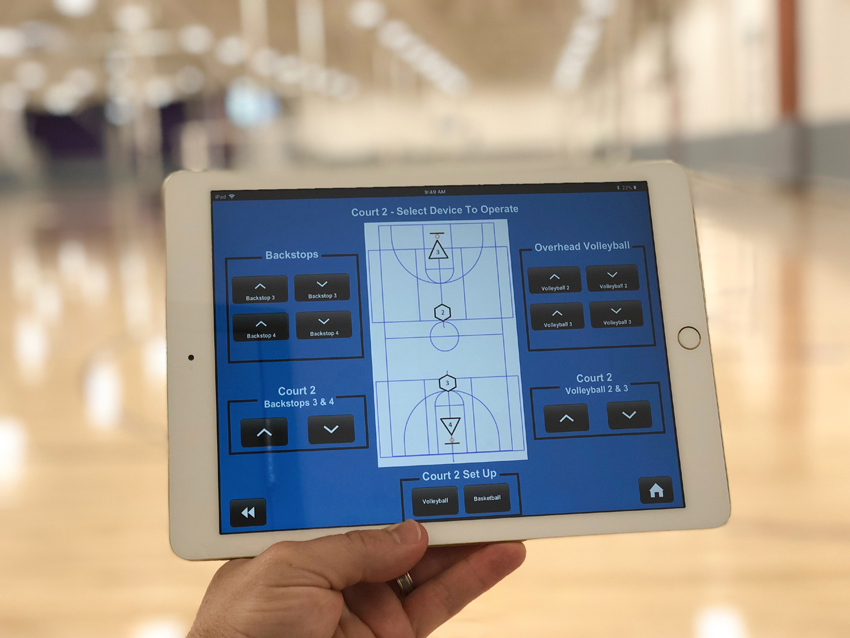
Photo courtesy of Draper Inc.
The graphic interface for custom programmed control systems allow for easy, one-tap control for different tasks.
Conclusion
Gym owners now have access to a variety of advanced control systems. Offering considerable convenience, they can set up their equipment in a fraction of the time than it has traditionally taken. This translates to significant labor savings and, particularly with pay-to-play facilities, enhanced revenue.
At the same time, selecting the right control system is very important and best done with early input from the manufacturer. Architects will be best equipped to provide their clients with the best technological solutions by tapping into the control manufacturer’s expertise and coordinating with the owner, contractor, and manufacturer early on in the design process.
Barbara Horwitz-Bennett is a veteran architectural journalist who has written hundreds of CEUs and articles for various AEC publications. www.bhbennett.com







